
|
NOTE: The gauge info for the Clear Fork changed in 2004 due to an arbitrary adjustment made to
the Cowlitz at Packwood gauge. They now add 900 cfs to this gauge, artificially inflating the flow. I have no idea why
they started doing this, but be aware that this guage overstates the flow, and may confuse those who are using the Bennett
guide for flows.
Because the Cowlitz at Packwood gauge has become somewhat arbitrary and subject to tampering by the Forest Service, I would recommend using the Cispus at Randle as a baseline flow for the Clear Fork until further notice. |
The Clear Fork of the Cowlitz roars off the flank of Mount Rainier
through a deep, otherworldly canyon accessible in most places only by
kayak. This nearly pristine stretch of Ayance Canyon is a very special
place that few people will ever see because the price of admission is very
high.
This is my all time favorite creek- nothing else even comes close! For
serious class V paddlers only, this run has few peers in the Pacific
Northwest. Crystalline water, breathtaking scenery, and non-stop big drops
combine to make a run down this section an unforgettable class V to V+
experience.
The guidebook description for this run is enough to keep most folks away. Clear Fork pioneer Bill Bowey describes it as "one of the crown jewels of Washington's steep creeks with huge, steep drops and mind boggling boulder gardens." He also calls it "a very demanding run not suitable for part-time class five paddlers." The Clear Fork is very steep, dropping an average of 240 fpm for five miles, with some sections dropping well over 300 fpm. When you combine that kind of gradient with the pool drop nature of this creek you have an explosive combination!
There are eight waterfalls on this section ranging from ten to eighteen feet, and most of the time you can't see more than a hundred feet downstream because of the narrow, twisty nature of the canyon walls. Even the very best boaters portage two to five times on this run, and if you go up there you'd better be ready to run some rapids you might ordinarily portage or you may be spending the night. (This run has a lot of scouting and the portages can be physically demanding depending on what you decide to run; your fitness level could very well determine how much you enjoy the Clear Fork.)
The creek starts out innocently enough with a couple of small drops, and then it rounds the corner and plunges over a three part thirty foot drop known as Entrance Exam. One short pool below Entrance is a technical lead in to a ten foot waterfall and then the creek takes off like a runaway freight train. (Bill describes this opening barrage of big drops this way in the guidebook: "If you are scared now, hike out... the Clear Fork just gets more challenging downstream!") If all of this just whets your appetite then you have found your new favorite run!
The first part of Entrance Exam is a twenty foot long slide through a heinous looking crack which careens off of the left wall at the bottom. This was just too much to deal with as a warm up so we portaged. John has run this first drop before but he knows a guy who got his helmet torn off when he flipped going through the crack so he felt like walking this time. The portage is difficult and involves a slippery catwalk over wet, smooth rock with the river frothing hungrily into the wall six feet below you. Luckily I have a few years of rock climbing experience under my belt so I was able to ease the boats across while Josh and John looked on apprehensively. We seal launched back into the creek just below the crack and immediately plunged over the last part of Entrance Exam- a twenty foot double falls that was just about as good as they get!
The first drop on Entrance Exam. The narrowness of this crack is the
reason some folks portage this first one. I think more people would run
this drop but if you look downstream you can almost see the top of the two
tiered twenty foot falls on the left. You have little time to recover if
something goes wrong on this first drop!
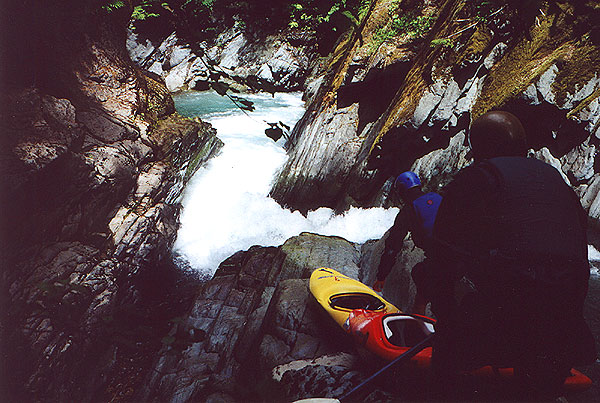
Josh Knapp sails over the two tiered twenty footer at the bottom of Entrance Exam.
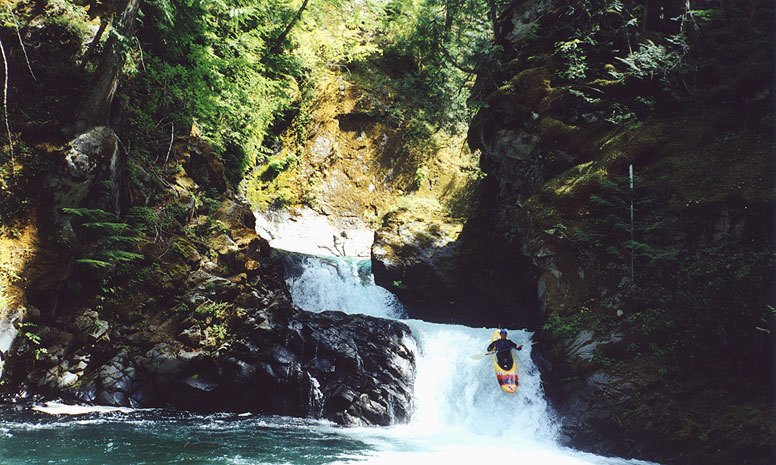
Josh lines up on the sixth rapid in the canyon. In the background you can see the two drops below Entrance Exam- a ten foot falls and a steep, twisty drop just downstream. Entrance Exam is not visible in this picture.
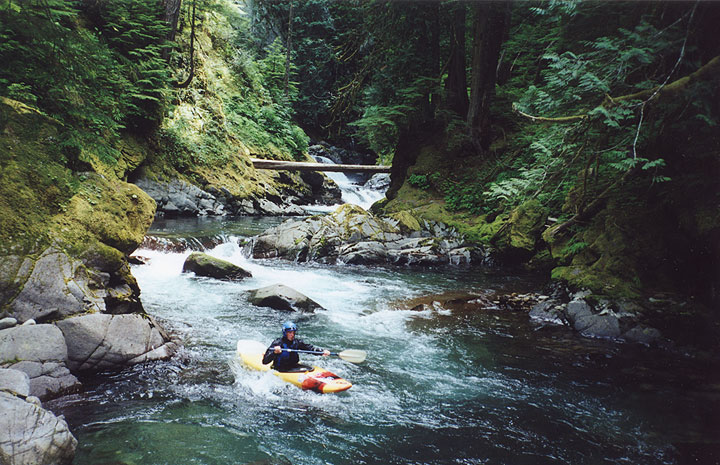
Gabe Flock enters a drop while Steve Stuckmeyer checks the rest of the rapid from an eddy below.
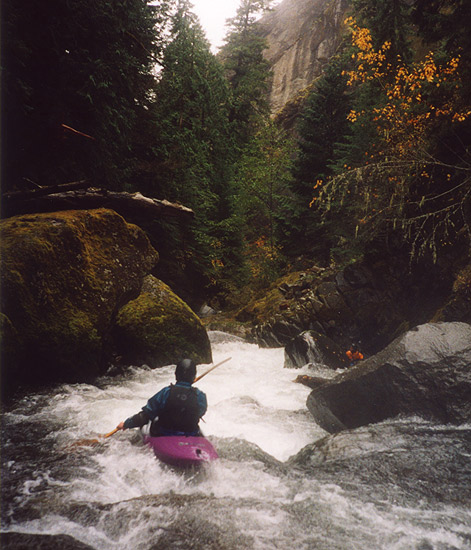
I got in my boat, checked my line, took a deep breath, launched off of the rock into the creek below. There was no time to think- what happened next was pure reactionary boating. I plunged into the fast current, pivoted, and suddenly found myself careening downstream along the rock wall and then I was soaring over a 13 foot waterfall! I landed next to a grinning Josh in a small circular punchbowl carved into the rock wall. On the far side of the bowl there was another horizon line as the creek poured out of the punchbowl over another ledge, then another...
John spun out into the violent churn from the falls above and tore off over the edge of the bowl, dropping into the void again with Josh and I close behind. I'm pretty sure this is where my adrenaline glands blew out, and we had only gone about a mile! Downstream we got out to scout waterfall number six, a narrow fifteen footer that we all ran...
The author runs waterfall number six...

Just downstream there was a rapid that had a large vertically pinned log at the bottom. I started too far left at the top of the rapid and suddenly found myself pasted against the log in fast water with the bottom of my boat downstream against the log. Before my boat could settle into the pin I got my paddle blade on the bottom of the creek and worked my boat back and forth as the current crashed down into me from above. The water was about five feet deep so I hung on my paddle blade to keep my head above the water. I was mostly worried that the current would blow my skirt which may have forced me to swim but luckily it held and I was able to rock my boat back and forth and work myself off of the log. Josh had gotten out across the creek and watched intently as I freed myself after about half a minute or so. I was a little shaken up by this incident so I portaged a couple of easier drops downstream that I would have ordinarily have run, and then we arrived at waterfall number seven, which John and I portaged. At this falls the flow divides at a huge boulder, with half going to the left into a huge dead end siphon while the other half goes right over a technical 18 footer.
This falls is trickier than most because the right side glances off of the wall at the bottom and the lead in is pushy, technical, and very narrow. Josh came down and when he launched off the lip he twisted sideways in midair in order to put his boat between him and the rock wall! In spite of this acrobatic defensive measure he ended up missing the wall completely and plunged cleanly into the foam below. He was underwater for a few seconds and then to my amazement he levitated up ten feet downstream from the maul at the base of the falls totally upright! "That kid's a frickin' genius!" I said, shaking my head as I stowed my rope and got ready to go. Josh later said that he was cartwheeled a few times under water before he surfaced!
Josh twists to protect himself from the wall at waterfall number seven.
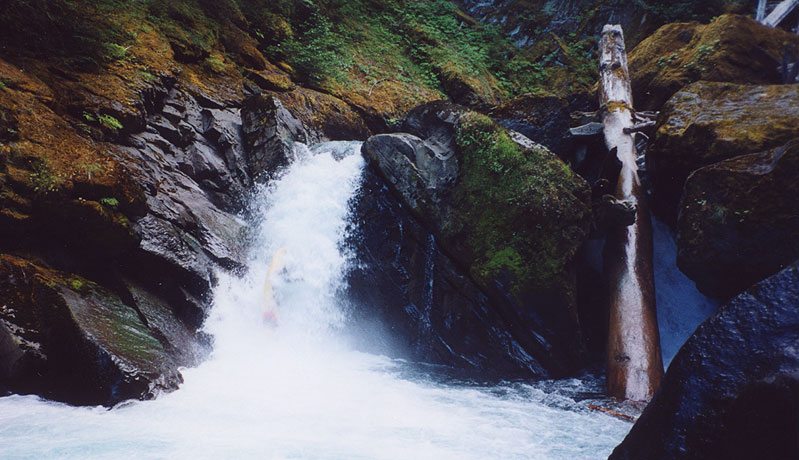
Downstream the creek kept coming with non-stop big drops. There were more ledges, huge boulder gardens, and complex rapids with sticky holes and funky hydraulics. There was also remarkably little wood though the occasional log did keep us guessing- we scouted an awful lot.
Finally we arrived at the Palisades, a spectacular array of towering columnar basalt walls that soar two hundred feet overhead and stretch as far as the eye can see. The view is breathtaking, but our paranoia kept our eyes glued to the creek as we began to approach what John calls 'the really bad neighborhood.' Soon the gradient began to skyrocket and we got out on the right to portage a two hundred yard series of class V+ to VI rapids. Many of these drops have been run, but we were definitely not willing (or able) to do so!
John and Steve near the end of the big portage.
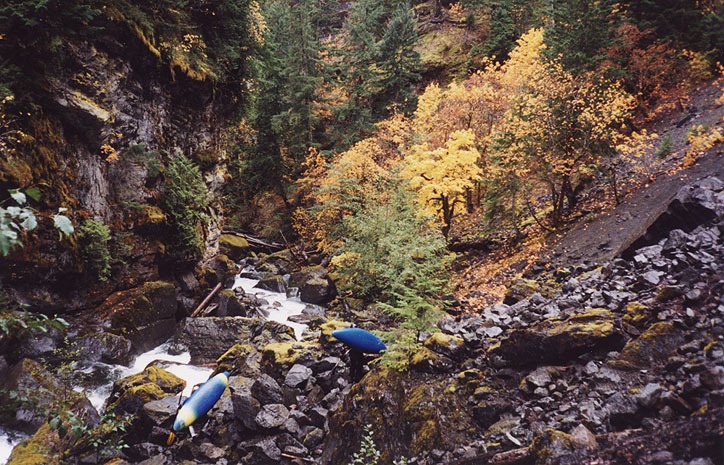
Below the portage the gradient eased back down into the 200 fpm range again as the creek tore down through another long series of class IV-V boulder choked drops. Soon we eddied out and John said excitedly "All right, this is one of the best drops on the run!!"
John runs the last falls on the Clear Fork.
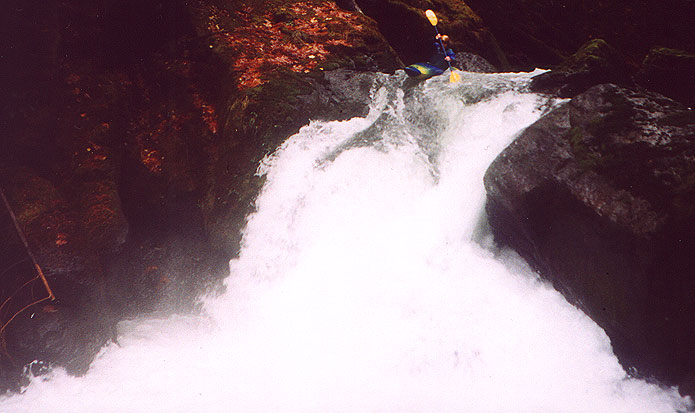
John Whaley eddy hopping below the Palisades. There are many, many boulder gardens like this on the Clear Fork.
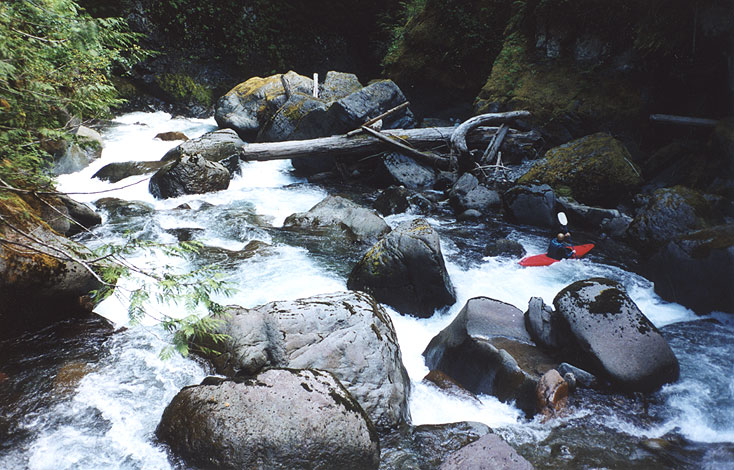

As a footnote, one of the things that amazed me about this run was the fact that there was very little wood on it. In five miles I think we only portaged three logs, and none of these were in any of the big drops. I think that most of this is due to the fact that the Clear Fork is in the Gifford Pinchot National Forest and the Forest service has controlled logging here. When I think of all of the creeks that have been ruined by clear cutting (Oregon's Christy Creek comes to mind) it makes me ill, but it is nice to know that runs like the Clear Fork still stand tall and proud. Come see why this run is worth protecting!
A parting shot... John scouting a drop somewhere on the Clear Fork.

Flows and Access: The first time we did the Clear Fork the flows on the web were exactly in the middle of the range recommended in the guidebook. Pat Welch's internet guages Cowlitz at Packwood was reading 1450 and the Cispus at Randle was 800 cfs. The guidebook's recommendation for late July seems to hold as well, especially in an average snow year. Probably mid to late July would be good when there is an average sized snowpack on the mountain. We have also done this run in the Fall right after the first big rains of the year and that was a good time too. (Actually, any time is a good time for the Clear Fork, unless it is high, then I stay away..) If you want to find out more about this run, consult Jeff Bennett's "A guide to Whitewater Rivers of Washington" (2nd ed), a book no serious northwest paddler should be without.